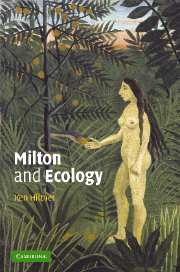Book contents
- Frontmatter
- Contents
- Acknowledgments
- Preface
- Introduction
- PART I HAVING PLACE
- 1 Place defined: the ecological importance of place
- 2 Place given: Eve as the garden's spirit of place
- 3 Place lost: Eve's Fall as an uprooting
- 4 Place regained: Sabrina puts down roots
- PART II THE UNDERLYING IMPORTANCE OF PLACE
- Notes
- Select bibliography
- Index
4 - Place regained: Sabrina puts down roots
Published online by Cambridge University Press: 15 December 2009
- Frontmatter
- Contents
- Acknowledgments
- Preface
- Introduction
- PART I HAVING PLACE
- 1 Place defined: the ecological importance of place
- 2 Place given: Eve as the garden's spirit of place
- 3 Place lost: Eve's Fall as an uprooting
- 4 Place regained: Sabrina puts down roots
- PART II THE UNDERLYING IMPORTANCE OF PLACE
- Notes
- Select bibliography
- Index
Summary
Does man still dwell calmly between heaven and earth?
Heidegger, Discourse on Thinking“They hand in hand with wandering steps and slow / Through Eden took thir solitaire way” (12.648–49). With these lines Paradise Lost closes, but after Adam and Eve take that long walk out of Paradise, what next? Once lost, how is Paradise to be regained? The sad truth is that the situation has gotten so out-of-hand that, try as they might, Adam and Eve simply cannot regain Paradise – regardless of what they do to atone. It is somewhat surprising, then, that Milton did not give greater emphasis to what the Son did to atone for humanity in Paradise Regained; instead the poet focuses on the decisive scene in the desert where the Son would “first lay down the rudiments / Of his great warfare” (1.155–58) in order to provide what is both his plan for atonement and arguably a new paradigm of human action. As I shall argue in the following sections, in Paradise Regained not by looking to what the Son did on the cross to atone but in laying down the rudiments of a startlingly new manner for humans to approach their world (for example, by resisting the temptation of Greek learning, Roman power, and exalted Judaic thinking), Milton delivers a fair measure of the responsibility of regaining Paradise (place) in the here and now back to humankind.
- Type
- Chapter
- Information
- Milton and Ecology , pp. 55 - 72Publisher: Cambridge University PressPrint publication year: 2003



